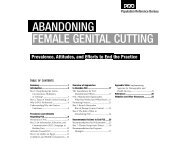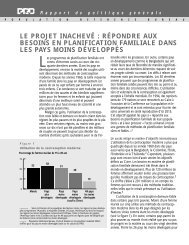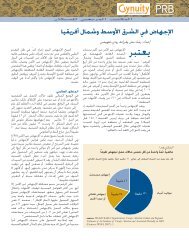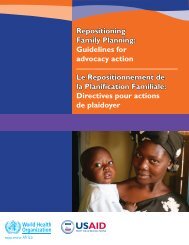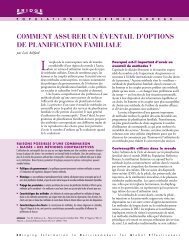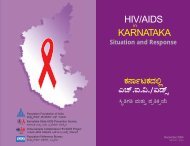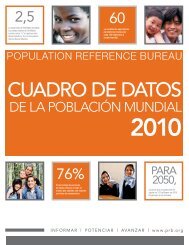addressing gender-based violence through usaid's health ... - IGWG
addressing gender-based violence through usaid's health ... - IGWG
addressing gender-based violence through usaid's health ... - IGWG
Create successful ePaper yourself
Turn your PDF publications into a flip-book with our unique Google optimized e-Paper software.
Youth Programs<br />
Reasons WHY youth programs should<br />
address <strong>gender</strong>-<strong>based</strong> <strong>violence</strong><br />
Substantial proportions of girls and young women<br />
experience physical and sexual <strong>violence</strong> in nearly every<br />
geographical setting (Krug et al., 2002). Surveys among<br />
sexually experienced adolescent girls in countries<br />
around the world have found rates of forced sexual<br />
debut ranging from 7 percent in New Zealand to 46<br />
percent in the Caribbean (Heise and Garcia-Moreno,<br />
2002), and these rates are likely to be underreported.<br />
Physical <strong>violence</strong> by intimate partners often begins<br />
Selected reasons why youth programs<br />
should address <strong>gender</strong>-<strong>based</strong> <strong>violence</strong><br />
●<br />
●<br />
●<br />
●<br />
●<br />
●<br />
●<br />
●<br />
Substantial proportions of girls and young women<br />
experience forced sexual debut, child sexual<br />
abuse, and other forms of sexual <strong>violence</strong> in<br />
virtually every geographical setting.<br />
Physical <strong>violence</strong> by intimate partners often begins<br />
within the first years of dating and marriage.<br />
Sexual abuse in childhood and adolescence<br />
has been linked to a host of poor <strong>health</strong><br />
consequences, including unintended pregnancy,<br />
abortion, depression, and STI/HIV transmission.<br />
Survivors of sexual abuse face a higher risk of<br />
substance abuse, multiple sexual partners, and<br />
inability to negotiate contraception.<br />
Youth reproductive <strong>health</strong> programs cannot<br />
assume that sexual activity is always voluntary or<br />
consensual.<br />
Ignoring <strong>gender</strong>-<strong>based</strong> <strong>violence</strong> can jeopardize the<br />
effectiveness of interventions, such as prevention<br />
of unintended pregnancy and STI/HIV.<br />
Youth represents an ideal opportunity for GBV<br />
prevention because attitudes and beliefs about<br />
<strong>gender</strong> norms and <strong>violence</strong> are still forming.<br />
There is an urgent need to improve the<br />
institutional response to girls and young women<br />
who experience <strong>violence</strong>—particularly sexual<br />
<strong>violence</strong>.<br />
Source: Krug et al., 2002.<br />
within the first few years of dating and marriage, and<br />
young married women are particularly vulnerable<br />
in some settings. The consequences of <strong>violence</strong> and<br />
abuse for the <strong>health</strong> and development of girls and<br />
young women are considerable. For example, sexual<br />
coercion and abuse has been linked to unintended<br />
pregnancy, early childbearing, abortion, substance<br />
abuse, depression, suicide, and STI/HIV transmission.<br />
Unfortunately, the response from families, schools,<br />
<strong>health</strong>care providers, law enforcement, and social<br />
services is often poor or nonexistent.<br />
Many reproductive <strong>health</strong> programs for youth—<br />
particularly those devoted to preventing unintended<br />
pregnancy and HIV transmission—often promote<br />
“responsible” decisionmaking, without acknowledging<br />
the extent to which sexual and reproductive<br />
behaviors and outcomes are affected by <strong>violence</strong> and<br />
coercion. This should change in order to improve the<br />
effectiveness of these programs.<br />
Moreover, adolescence is a time in life when attitudes<br />
and beliefs are still forming, and it appears to be easier<br />
to change norms and attitudes about <strong>gender</strong> equity and<br />
non<strong>violence</strong> among youth than among older women<br />
and men. Thus, youth represents a major opportunity<br />
for preventing <strong>gender</strong>-<strong>based</strong> <strong>violence</strong>.<br />
HOW youth programs can address <strong>gender</strong><strong>based</strong><br />
<strong>violence</strong><br />
1) Require all reproductive <strong>health</strong> programming<br />
for youth to address sexual coercion and abuse.<br />
Reproductive <strong>health</strong> programs for youth cannot<br />
assume that sexual activity is always voluntary or free<br />
from coercion. Providing information, promoting<br />
“responsible” decisionmaking, or encouraging<br />
abstinence alone is not enough given what is known<br />
about the prevalence and patterns of sexual <strong>violence</strong><br />
among young people. Sexual and reproductive <strong>health</strong><br />
programs need to address <strong>gender</strong> equitable norms,<br />
power imbalances within relationships, non<strong>violence</strong>,<br />
and negotiation skills among both girls and boys.<br />
Part II-E<br />
Youth Programs<br />
33




